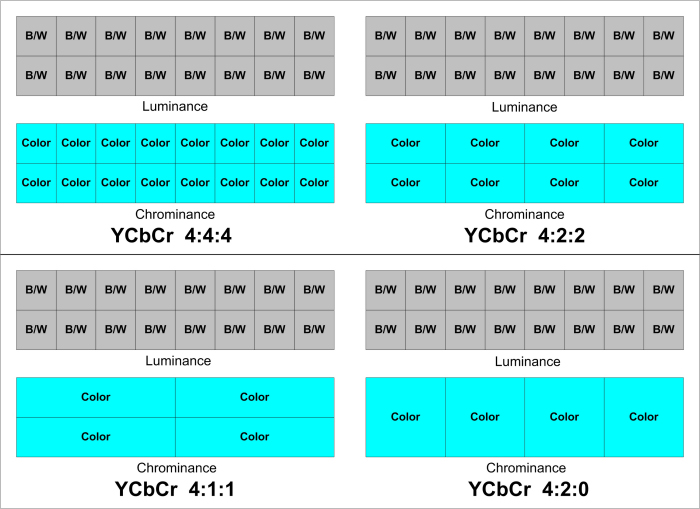Digital Component Video
Digital Component Video Y' Cb'Cr'
Digital component video uses a modified form of the Y' U' V' color format (analogue format). This format is called Y' Cb'Cr'. The Cb' component is the blue color difference component, similar to the U' component in Y' U' V'. Likewise, Cr' is the red color difference, similar to V'.

CCIR Standard for digital SD-TV (PAL, NTSC, SECAM)

CCIR Standard for digital HD-TV (1080i, 1080p, 50Hz, 60Hz)
Chroma Subsampling
The human eye is less sensitive to chroma differences (color) than luma differences (grey scale). Color information can be reduced without visibly noticing. This can be achieved by reducing the sample rate for the chroma signals compared to the sample rate for the luma signal. The subsampling is defined by a 3-digit ratio, like "4:2:2".

different color sampling methods (16 pixels only)
4:4:4 / 4:2:2 / 4:1:1 / 4:2:0
The terminology: "4" is always the first number as a base, corresponding to the luminance part, if the luminance is captured fully (100%).
In 4:4:4 digital component video, the Y' component and both chroma components are sampled at the same sample rate. Each sample of luminance corresponds to one Cb sample and one Cr sample (like full RGB bandwidth, RGB and YCbCr and be converted fore and back).
In 4:2:2 digital component video, the Y' component is sampled at twice the rate as each of the chroma components Cb' and Cr'. If the basic sample rate is 74.25 MHz, the
Y' component is sampled at a rate of 74.25 MHz and the Cb' and Cr' components are sampled at half the rate: 37.125 MHz. In the 4:2:2 sampling per sample we have 50% luma and 50% chroma information (the chrome word is again 50% Cb' and 50% Cr'). If the 4:2:2 signal has a color depth of 16 bits per pixel, it equals the perceptual quality of a 24-bit RGB signal.
In the HDTV digital component video the luma and the chroma information is treated separately. For 10-bit digital video, there is a 10-bit luma channel and a 10-bit chroma channel. The chrome samples alternate between a Cb' word and a Cr' word each time.
In 4:1:1 digital component video the color resolution is quartered. For two neighboring luminance sample only one chroma sample with 50% Cb and 50% Cr is used.
In 4:2:0 digital component video the resolution i quartered too, but the color resolution is halved in both the horizontal and vertical directions.
In special formats like 3:1:1, three quarters of the horizontal resolution is captured. 8:4:4 is a format that uses two 4:2:2 scanner that are bonded together for the full chroma recording and a double bandwidth of luminance (high end film scanners).
Display Technology
Most, if not all, displays or projectors have to rescale a component video signal (like YCbCr 4:2:2) back to a pure RGB signal. This is the reason why RGB images (PC-graphics) are displayed without any problem on any flat display etc. but displaying component video is sometime not fully implemented. It demands a more sophisticated internal scaler. Any display showing interlaced video content must have an internal scaler that is responsible for the internal de-interlacing, that also does the YCbCr-RBG conversion.